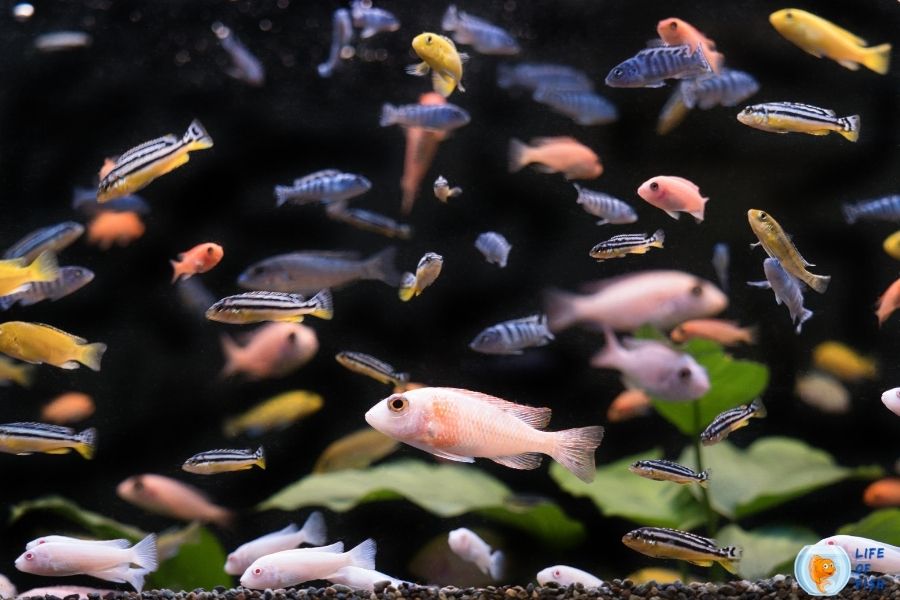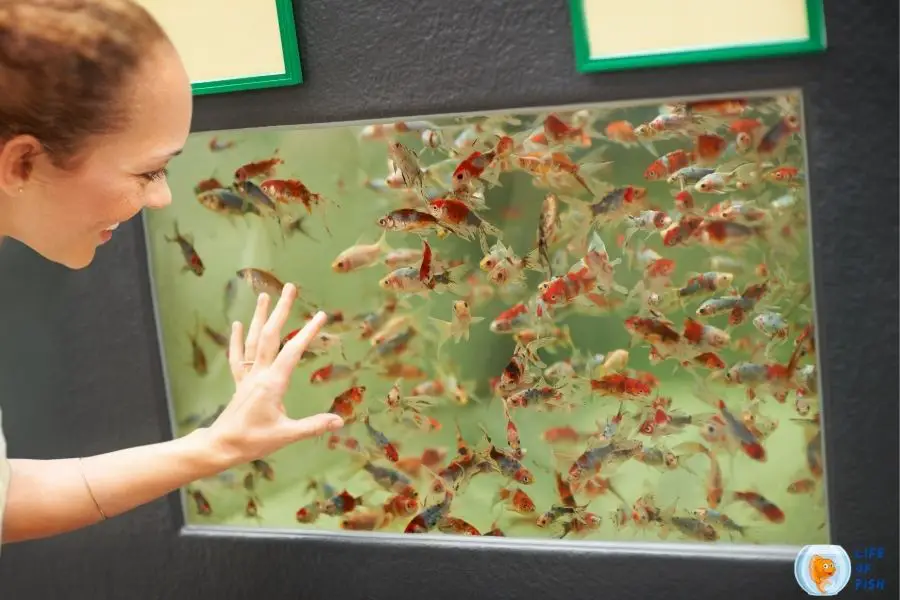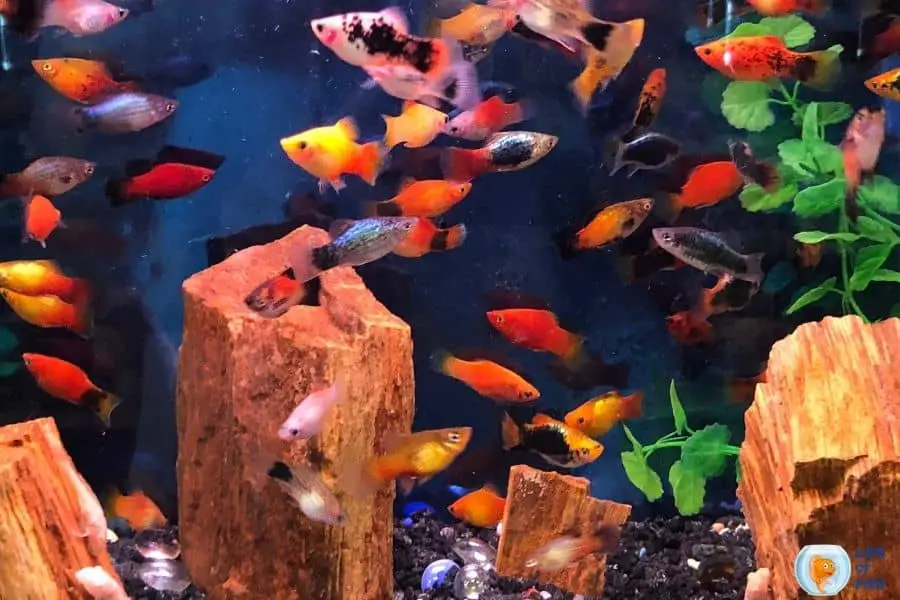Can Fish Recover From Ammonia Poisoning? Yes. While it is well known as the biggest fish killer in aquariums if caught early enough and with proper treatment, fish can recover from ammonia poisoning.

Ammonia poisoning is a life threat for your fish and can easily happen in your aquarium. Ammonia is present in all aquariums from the decay of fish waste and uneaten food.
It is also produced when your fish respire and excrete. Ammonia is highly toxic to fish at any concentration, and even low levels can cause serious health problems.
How can we save those poor lives? Let’s discuss this in this article.
What is ammonia poisoning?
Jump To
- 1 What is ammonia poisoning?
- 2 How Does Ammonia Affect Fish?
- 3 Is ammonia poisoning painful for fish?
- 4 Can Fish Recover From Ammonia Poisoning?
- 5 How long does it take for fish to get over ammonia poisoning?
- 6 Ammonia poisoning symptoms in fish
- 7 How do you treat fish with ammonia poisoning?
- 8 How to know if the fish is recovering?
- 9 Causes of Ammonia Poisoning and how to prevent them
- 10 Related questions
- 11 Conclusion
Ammonia (NH3) is a compound of nitrogen and hydrogen. It is a waste product in fish tanks and is produced by the decomposition of uneaten food, decaying plants, and waste material.
Ammonia is also produced when your fish respire and excrete. Under the right conditions, Ammonia can quickly build to toxic levels in your aquarium.
This often happens when the nitrogen cycle is not yet established in a new aquarium or when there is a rapid increase in the amount of waste produced (such as overfeeding, adding too many fish at once, or not cleaning the tank frequently enough).
When the Ammonia levels are too high, it can affect your fish in a number of ways. It can cause several symptoms as well as death in extreme cases. Experts call it Ammonia poisoning.
How Does Ammonia Affect Fish?
Ammonia is corrosive and will burn the fish’s skin, eyes, and gills. Gill’s ability to absorb oxygen will be impaired as the mucous membranes are destroyed.
This causes the fish to gasp for air at the water’s surface, which can lead to death. Ammonia can also damage a fish’s kidney, liver, and other organs.
Ammonia will cause your fish to become stressed and more susceptible to disease at low levels. Even at very low levels (0.02 ppm), Ammonia will damage the gills and cause stress.
Stress caused by Ammonia can make your fish more susceptible to disease and can even cause death.
Is ammonia poisoning painful for fish?
Ammonia poisoning is extremely painful for fish as it literally burns their skin, eyes, and gills. The damage caused by Ammonia can be so severe that it may even cause death in most cases. This is why we should act fast and treat those poor things.
Can Fish Recover From Ammonia Poisoning?
Although most fish die because of Ammonia poisoning, fortunately, there is hope for fish that have been poisoned by Ammonia.
If the ammonia levels are not too high and you act quickly, your fish stands a good chance of recovery. To recover your fish, you just need to act fast and treat your fish before it gets infected with bacterial infections.
How long does it take for fish to get over ammonia poisoning?
If you treat your fish before it’s too late, it will take only three to five days for your fish to recover from ammonia poisoning.
For this, you first have to identify symptoms of ammonia poisoning in fish. After that, you must take proper steps for ammonia removal from the tank and provide first aid to your fish.

Ammonia poisoning symptoms in fish
When a fish is poisoned by Ammonia, it will experience a number of symptoms. The most common symptoms are:
Increased mucous production
When Ammonia is present, fish will start producing more mucus to protect themselves from the poison. This increased mucus production will make your fish’s skin and fins look slimy.
Red or bleeding gills
Ammonia will damage your fish’s gills and cause them to become red or bleed. This is a serious symptom, and you should take steps to remove the Ammonia from your tank as soon as possible.
Gasping for air at the surface of the water
As the Ammonia starts to damage your fish’s gills, they will not be able to absorb oxygen as efficiently. This will cause your fish to start gasping for air at the surface of the water.
Dropping of fins
If the ammonia levels are high enough, it will start to damage your fish’s fins. The fins will become ragged and may even drop off.
Red, irritated skin
Ammonia will also cause your fish’s skin to become red and irritated. In severe cases, the Ammonia may even start to eat away at the skin.
Discoloration of body
Ammonia can also cause your fish’s body to become discolored. The most common symptom is a whitish tinge on the body and fins.
Lethargy and loss of appetite
Ammonia poisoning will cause your fish to become lethargic, and they may even lose their appetite.
Secondary infections
If the ammonia levels are high enough, it can also cause secondary infections. These are usually bacterial infections that take advantage of the Ammonia damaged tissues.
When fish are infected with secondary infections, it is usually not treatable. So, removing Ammonia from your tank is important as soon as possible.
In extreme cases, death
Sometimes, all of these symptoms happen quickly, and you won’t have a chance to remove the Ammonia from your tank before it’s too late. In these cases, the fish will die quickly from ammonia poisoning.

How do you treat fish with ammonia poisoning?
You should test the water for ammonia levels to confirm if it is Ammonia poisoning. If the Ammonia levels are high, you need to take steps to remove them from the water.
Step 1: Change 50% water
The standard Ammonia level for a fish tank is 0 ppm. So, if the levels are above that, they need to be removed. The best way to remove Ammonia is to do a water change. You should do a water change of at least 50%.
Depending on how much Ammonia is present in your fish tank, you will have to make a number of water changes within a short period of time. Perform water changes until the Ammonia level drops below 1ppm.
Step 2: Use an Ammonia Remover
After you have done a water change, you need to add an Ammonia remover to your tank. You can remove any remaining ammonia by using a PH control product.
Usually, this is required if your fish is severely distressed. If your fish seems fine after water removal, you might not need to do this step.
Step 3: Restrict Feeding
Once you have removed all the Ammonia from the tank, you have to stop feeding your fish to prevent any more Ammonia from entering the tank.
In severe cases, you will have to restrict feeding to several days. You should only start feeding your fish again when the Ammonia levels have stabilized.
Step 4: Do not add any new fish
You should not add any new fish while your fish are recovering from Ammonia poisoning. New fish will add more Ammonia to the tank and can cause your fish to relapse.
You should only add new fish when the Ammonia levels have been stable for at least a week.
Step 5: Treat Ammonia burns
If your fish have visible Ammonia burns, you need to treat them with an antibiotic. Ammonia burns are usually bacterial infections that take advantage of the Ammonia-damaged tissues.
If bacteria are just starting to take over, your fish will recover with treatment. If the infection has progressed too far, your fish might not recover.

How to know if the fish is recovering?
If your fish is recovering from Ammonia poisoning, you will see the following changes:
- The fish will start to eat again.
- The fish will become more active.
- The fish’s fins will start to regrow.
- The wound on the skin and gills will start to heal.
- The fish’s color will start to come back.
- The fish will start to breed again.
If you see any of these changes, it means that your fish is recovering from Ammonia poisoning.
Causes of Ammonia Poisoning and how to prevent them
Now that you know how to treat Ammonia poisoning, you should now learn the causes of Ammonia poisoning and how to prevent them.
New fish tanks that are not properly cycled
This is something most new fish owners do not know about. When you first set up your fish tank, it must go through a “cycling.” This is when bacteria that eat Ammonia and nitrites form in your fish tank.
These bacteria are essential for your fish’s health and your fish tank’s stability. During the cycling process, these healthy bacteria establish their colonies on the surface of the tank, start to eat up harmful nutrients like Ammonia and Nitrite, and release harmless Nitrites into the aquarium.
Without these bacteria, your fish will eventually die from Ammonia poisoning.
The cycling process usually takes 6-8 weeks to complete. During this time, you should not add any fish to your tank.
You can speed up the cycling process by adding live plants, adding beneficial bacteria products like Aqueon® PURE, or using a fishless cycle method.
Overcrowding
Overcrowding is another common cause of Ammonia poisoning. When you have too many fish in your tank, they produce too much waste. This waste degrades into Ammonia, which can rapidly develop to lethal amounts and harm your fish.
You should only add as many fish as your tank can handle. A good rule of thumb is 1″ of fish per gallon of water.
So, so if you have a 10-gallon tank, you should only add 10″ of fish. This rule is even more important if you have a small tank or if you have fish that produce a lot of waste.
Poor water quality
If you do not properly maintain your fish tank, the water quality will start to decline. This decline in water quality can lead to Ammonia poisoning.
You should do a partial water change (25-50%) every week to remove any toxins that have built up in the water. You should also clean your filter and vacuum the gravel to remove accumulated waste.
Decaying matter in the tank
If there is any decaying matter like dead fish in your fish tank, it will release Ammonia into the water. This can quickly poison your fish.
You should remove any decaying matter from your tank as soon as you see it. You should also do a partial water change to remove any Ammonia that has been released into the water.
Feeding your fish too much
If you feed your fish more food than they can eat, the uneaten food will decay and release Ammonia into the water. This can quickly poison your fish.
You should only feed your fish as much as they can eat in 2 minutes. If there is still food left after 2 minutes, you are feeding them too much.
Using chemically treated tap water
Most companies use chloramine to treat their water system. While chloramine is very effective in disinfecting the water, it is bonded with Ammonia, which is toxic to fish.
However, that does not mean that you shouldn’t use tap water for your fish tank. There are ways to make your tap water safe for fish.
To make tap water safe for your fish, you should use a water conditioner that removes chloramine from the water before adding it to your fish tank.
Products like API Tap Water Conditioner and Aqueon® Water Conditioner do an excellent job of removing chloramine from the water.
Related questions
How fast does ammonia poisoning kill fish?
Depending on the level of Ammonia in the water, it can kill fish within hours or days.
How to check Ammonia levels in a fish tank?
An Ammonia Test Kit is the best way to check Ammonia levels in a fish tank. For this, API® Ammonia Test Kit is recommended.
Additionally, you can use a combo kit like API Freshwater Master Test Kit to test for Ammonia, pH, Nitrite, and Nitrate. These products contain everything you need to test the water quality in your fish tank.
Conclusion
Ammonia poisoning is a serious problem that can kill your fish. However, there are ways to prevent it.
Further, fish can recover from Ammonia poisoning if the levels are not too high and you take immediate action. By following the tips in this article, you can keep your fish safe from Ammonia poisoning.
Read Next : Can You Put A Fish Tank Near A Radiator? (Not A Good Idea)
Also read: http://www.examlabs.com
